Black banner of the Caucasus: anarchists of the beginning of the twentieth century have not managed to destroy power in Georgia
"Tergdaleulebi"
It is worth recalling here that Georgia has long been a peripheral region. Certain immigrants from Georgia, of course, studied at metropolitan universities, have been abroad, but in general, this region of the Russian Empire had its own national flavor, which was not very compatible with anarchist ideology. Oppositional and radical sentiments in Georgia manifested themselves, above all, in the form of Georgian nationalism, in part - Narodism. By the way, some Georgians participated in the activities of populist organizations in the territory of Russia itself.
In Georgia, the revolutionary movement, up to the beginning of the twentieth century, was practically absent in its Russian understanding. Moreover, it was surprising that in the first decade of the twentieth century anarchist organizations were activated here, and so intensified that the struggle against them became one of the key activities for local Bolsheviks. In particular, Joseph Dzhugashvili - Stalin himself devoted a series of articles to anarchists to criticism of anarchism or socialism? They were published in 1906-1907. Akhali Tskhovreba (Novaya Zhizn), Akhali Droeb (New Time), Chveni Tskhovreba (Our Life) and Dro (Time) in the Georgian social democratic newspapers.
Georgia’s long isolation from the all-Russian revolutionary movement was due to the fact that right up to the end of the 1850-s - the beginning of the 1860-s. almost all Georgian aristocratic youth went to study in military schools - cadet corps and military schools. Young Georgians were not sent to civilian universities, which were the citadel of free-thinking, at least in significant numbers. In 1860 in St. Petersburg, only about thirty young Georgians received higher education. However, even these modest figures played a very large role in spreading revolutionary ideas in Georgia, since Georgian youth, while studying in St. Petersburg, took the radical views of their Russian peers at that time and, returning to their homeland, introduced them to the environment of the Georgian intelligentsia. Since the beginning of the 1860-s, the facts of the participation of Georgians in the all-Russian revolutionary movement have been noted.
Thus, in 1861, 13 students from Georgia were prosecuted for participating in student demonstrations. Eight years later, when student unrest recurred, Nikolay Orbeliani, Vissarion Dzhaparidze and Faddei Beburishvili were sent to Georgia for participation in 27 March 1869 in them.
For the designation of Georgian intellectuals who received education in Russia, there was even a special term - “tergdaleulebi” (who studied beyond the Terek River). Gradually, it began to be applied to the entire generation of Georgian intelligentsia, which mastered the liberal and, in the minority, radical democratic views of their Russian peers. Some Georgians were destined to play a prominent role in Russian populism, including taking part in the formation of the all-Russian anarchist movement. One of them should be described in more detail, since for a long time he remained the second oldest after Peter Kropotkin veteran of Russian anarchism.
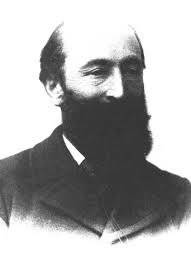 Varlaam Nikolayevich Cherkezov, also known as Cherkezishvili Varlaam Aslanovich (1846-1925) was born into a princely family that had not been very prosperous for a long time, but thanks to his noble birth, he managed to send his son to study in Russia. There Cherkezov and joined the Russian revolutionary movement. He took part in the Narodnik circle of the famous Sergei Nechaev, the author of the Catechism of the Revolutionary, then was arrested, in 1876, he fled and fled abroad. When the court decided in 1882 in Lyon about the placement of Peter Kropotkin in a French prison, Cherkezov decided to “go to the bottom” and for several years he lived in different countries of Eastern Europe, where he existed due to random earnings. From Austria-Hungary through Romania and Turkey, Barlaam Cherkezov in 1885, illegally returned to his native Georgia. There he worked as a private teacher in the family of Princess A. Mukhranskaya. In 1892, Cherkezov again went into exile. In London, he became involved in the activities of local anarchists, became quite well-known an anarchist press journalist. Up to the turn of the XIX-XX centuries. Cherkezov remained almost the only Georgian - an anarchist.
Varlaam Nikolayevich Cherkezov, also known as Cherkezishvili Varlaam Aslanovich (1846-1925) was born into a princely family that had not been very prosperous for a long time, but thanks to his noble birth, he managed to send his son to study in Russia. There Cherkezov and joined the Russian revolutionary movement. He took part in the Narodnik circle of the famous Sergei Nechaev, the author of the Catechism of the Revolutionary, then was arrested, in 1876, he fled and fled abroad. When the court decided in 1882 in Lyon about the placement of Peter Kropotkin in a French prison, Cherkezov decided to “go to the bottom” and for several years he lived in different countries of Eastern Europe, where he existed due to random earnings. From Austria-Hungary through Romania and Turkey, Barlaam Cherkezov in 1885, illegally returned to his native Georgia. There he worked as a private teacher in the family of Princess A. Mukhranskaya. In 1892, Cherkezov again went into exile. In London, he became involved in the activities of local anarchists, became quite well-known an anarchist press journalist. Up to the turn of the XIX-XX centuries. Cherkezov remained almost the only Georgian - an anarchist.Gogelia and foreign anarchists
The situation changed after in Geneva, which by the beginning of the twentieth century. became the center of Russian anarchist emigration, a group of Russian communist anarchists appeared abroad. Among its direct organizers and leaders was George Ilyich Gogelia (1878-1924), also known as Orgeiani. By the time of the creation of the group that adhered to the Kropotkin trend in anarcho-communism, the twenty-two-year-old Gogelia had time to study at the Kutaisi Theological Seminary and then, having left school, emigrated abroad.
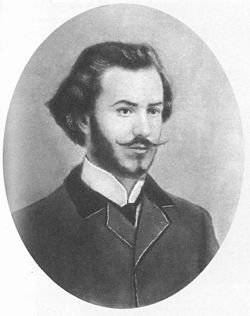 Initially, he studied in Lyon at the local agronomical college, and then entered the University of Geneva. It was in Geneva that he became the very Gogelia who entered history Russian anarchism among the most prominent speakers and publicists. Contemporaries noted the frenzy of Gogelia during his speeches and intelligence in communication “behind the podium”: “with restraint, without enthusiasm, he developed his outlook, showing great reading, deep conviction and conviction, calmly and thoughtfully listening to objections” (Kovalskaya E. My acquaintance with Komando Gogelia (Orheiani). - HQ and Link. 1925. No. 3 (16). Page 212).
Initially, he studied in Lyon at the local agronomical college, and then entered the University of Geneva. It was in Geneva that he became the very Gogelia who entered history Russian anarchism among the most prominent speakers and publicists. Contemporaries noted the frenzy of Gogelia during his speeches and intelligence in communication “behind the podium”: “with restraint, without enthusiasm, he developed his outlook, showing great reading, deep conviction and conviction, calmly and thoughtfully listening to objections” (Kovalskaya E. My acquaintance with Komando Gogelia (Orheiani). - HQ and Link. 1925. No. 3 (16). Page 212).In 1903, Gogelia and his wife, Lydia Ikonnikov, created the Geneva Group of Communist anarchists, Bread and Freedom. Strictly speaking, it was from this small circle that the history of the organization of the bread-and-food movement in the Russian anarcho-communist movement began. As a supporter of Kropotkin, Gogelia was rather cool about radical methods of struggle - terrorist attacks, especially non-motivated, directed against impersonal members of the "exploiting classes". Being engaged in publishing activities in Geneva, Gogelia established contacts with his fellow countrymen from other revolutionary movements. Since in the period Georgia itself, social democrats with a nationalist hue were active, the only chance for the Georgian radical intelligentsia to become familiar with anarchism was propaganda of the latter’s ideas in a social democratic environment. The “anarchization” of a part of the Georgian young intelligentsia began with the fact that among the social-democratic young people neo-popular ideas spread, which seemed more acceptable to Georgia than Marxism.
The newspaper Sakartvelo (“Georgia”) appeared in Paris, calling for the national autonomy of Georgia as part of the Russian Empire and establishing relations with other Georgian opposition members who lived in emigration. It was on the initiative of the publishers of Sakartvelo that a conference of the Georgian opposition was convened in 1904 in Geneva. It was attended by social democrats, nationalists, autonomists, there were even four anarchists. According to Georgy Gogelia, the conference became the starting point of the history of the anarchist movement in Georgia itself, since anarchists crystallized it as a special direction of the Georgian radical opposition. Gogelia himself, under the pseudonym Orgeiani, spoke at the conference with the report “A new trend in the labor movement - syndicalism”. Another anarchist, Tergeli, presented a report entitled Revolution and Revolutionary Tactics. Both texts were printed in Georgian and brought to Georgia, where they began to spread among the revolutionary youth.
The basis of the formation of the Georgian anarchist movement was the Socialist-Federalist Party of Georgia, founded by the publishers of Sakartvelo and integrating into its ranks representatives of a wide variety of ideological and political movements - from Georgian nationalists to anarchists. The latter played a very prominent role in the game, until the middle of 1906, almost controlling its leadership. Thus, prominent activists of the Socialist-Federalist Party were Georgy Gogelia, G.G. Dekanozov, A.T. Gabunia and even a veteran of anarchism Varlaam Cherkezov. At the conference of the Georgian opposition in Paris, which took place on September 30 - 4 of October 1904, the anarchists of Georgia - the Dekanozov and Gabunia - represented the Socialist Socialist Party of Georgia.
The Party Program Development Commission, formed in July 1906 at the second conference of the Socialist-Federalist Party, also consisted of two anarchists and three maximalists (the socialist revolutionaries maximalists were ideologically closest to anarchism). The direct compiler of the draft program of the party was George Gogelia.
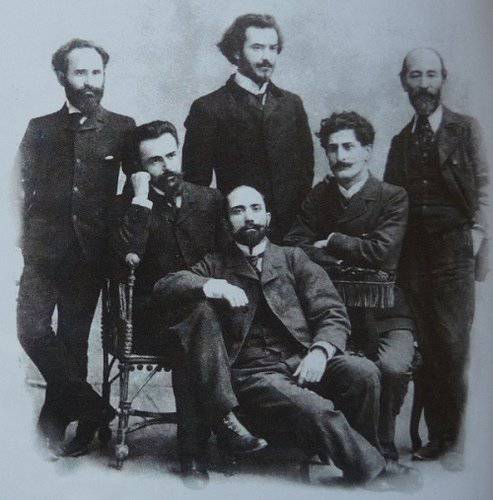
However, despite the fact that very many prominent activists and rank-and-file members adhered to the Anarchist or at least decentralistic and anti-state ideas in the Socialist Socialist Party, it was not possible to turn the PSF into a purely anarchist organization because of the opposition of the nationalist and autonomist wing. Therefore, in the end, anarchists had no choice but to leave the ranks of the PSF and create their own political organizations in Georgia.
Kutaisi, Tbilisi, Batumi ...
Kutaisi became the first center for the spread of anarchism in the Georgian land. By the beginning of the twentieth century, it was an industrially undeveloped city, where food and light industry enterprises operated. The Georgian anarchists, who arrived from Europe for the purpose of agitation in their native land, contacted like-minded Kutaisi Shalva Gogelia and began propaganda of anarchist ideas in the working environment. In 1905, they managed to create anarchist circles of workers at the Piralova Tobacco Factory and Lagidze Mineral Water Plant. The workers' groups united into a city-wide organization, which received the name Kutaisi group of communist anarchists “Commune”. Like other anarchist organizations that existed in the Russian Empire at that time, Kommuna began its activities with the expropriation of printing equipment. Having created their own underground printing house, the Kutaisi anarchists began to print their own leaflets, calling for workers, artisans and peasants to an anarchist revolution. There were seven kinds of such proclamations.
It was in Kutaisi that in the period described there were three leading Georgian anarchists - Barlaam Cherkezov, Shalva Gogelia and Mihako Tsereteli, thanks to whose participation in political debates with the Social Democrats the influence of the anarchist organization in the city significantly increased. Georgy Gogelia explained this by the fact that anarchists were inherently flexible in thinking, while the Social Democrats, whose backbone were former students of theological seminaries, if they had subject knowledge, were only mechanically learned.
As in other regions of the Russian Empire, the anarchists in Kutaisi were marked by a series of expropriations and murders. Thus, during the activity of the group four bourgeois were killed. The richest people of Kutaisi Kamullarii and Mundzhiev became victims of anarchist terror. In the days of the revolutionary events of 1905, anarchists built their own barricade on Kutaisi street. The militants of the group were armed with firearms weapons and even had a small field gun.
In Tbilisi (Tiflis), George Gogelia, who returned from Switzerland, initiated the dissemination of anarchist ideas. After the December uprising of 1905, some prominent anarchists from Kutaisi also moved to Tbilisi, and therefore, by the beginning of 1906, the anarchist movement in the city also had a great development. Although the anarchist group in Kutaisi was still more numerous, it was for Tbilisi that the role of the main organizational and ideological center of the Georgian anarchists was gradually consolidated. As in Kutaisi, anarchists began active agitation in the Tbilisi working environment, primarily among railway workers, as well as at the enterprises of Montashev and Adelkhanov. An Internationale Anarchist Communist Group was created, which included the workers of these enterprises, as well as a small group of typesetter workers who had just left the ranks of the Social Democrats.
The Tbilisi Anarchist Group, which played the role of a kind of intellectual center for Georgian anarchism, closely engaged in publishing. It created its own publishing house, specializing in the production of anarchist literature in Georgian and Russian. A total of about twenty books were published - both translations of foreign authors and works of Georgian anarchist theorists. In 1906, the Tbilisi anarchists began publishing their own print media. For some time, the weekly newspaper Nobati (Call) was published. The total number of 14 issues was from March 25 to 2 May, after which the newspaper was banned by the city authorities. However, 9 in May 1906. George and Shalva Gogelia released the newspaper “Khma” (“Voice”), which was also soon banned. 6 June 1906 was replaced by “Golos” by the newspaper “Musha” (“Work”), which was published every day under the editorship of George and Shalva Gogelia. The active publishing activity of anarchists caused a sharply negative reaction not only from the authorities, but also from the social democrats, who at that time were the main competitors of anarchists in the field of agitation in the working environment of the city.
As for the terrorist activity of Tbilisi anarchists, then, as in other cities of the empire, it also took place. Among the most notorious actions of anarchists in Tbilisi are: the murder of businessman Gamrikalov, a number of police officers, the largest anarchist expropriation of the treasury in the city of Dusheti on the territory of Russia, from where militants managed to steal 250 thousand rubles.
A rather active anarchist group appeared in the port of Batumi (then it was called Batum). At the head of a group called the Batumi Workers Union of Communist Anarchists, the Internationale was joined by a local activist of the anarchist movement, David Rostomashvili, also known by the nickname “Black Datiko”. Having established allied relations with the local socialist revolutionaries, the Batumi anarchists printed the appeal “Comrade revolutionaries!” To their printing houses, which became a kind of manifesto of the anarcho-communists in this port city. The main driving force behind the history of Batumi anarchists believed the creative energy of the revolutionary people, who had to overthrow political institutions and take over the land and enterprises in their hands. It was in Batumi that at one time the legendary anarchist Nestor Kalandarishvili was active - the future guerrilla commander, which will be discussed below.
Nine months of the commune in Gulgul
Speaking about the anarchist movement in Georgia during the revolutionary events of 1905-1907, one cannot ignore the events in the countryside. Anarchist groups did not exist here, but the ideas of anarchism themselves became widespread among some peasant leaders. Created so-called. “Red Hundreds” - peasant rebel detachments that engaged in arson of landlord estates, police stations and parish governments, killing provocateurs and certain particularly hated officials and landowners. So, four police provocateurs caught by the Red Hundred were drowned in the river.
In the small village of Gulgul in the revolutionary period a commune was created. Peasants were pushed to create it by a local landowner who sympathized with the ideas of anarchism. He distributed the land to the peasants, after which the latter destroyed all the walls and fences, declared the land public property. A peasant self-government was created. Agricultural tools were bought, bakeries, a school, and public houses were built for money collected from the entire village. The working day was also revised - a free schedule was established, combined with the communist distribution of products “according to needs”. All residents of Gulgul gradually became members of the commune, including well-to-do peasants, who, after a collective boycott by the villagers, began to suffer permanent losses and were forced to join the communards. The anarchist experiment continued in the mountainous Georgian village for nine months. In the end, government forces entered the village and arrested the most active members of the commune. In order to ensure order in the village, Cossack units were placed in public houses.
In the period 1905-1907. guerrilla war against the government was on the territory of almost the entire mountainous Georgia The movement of the “red hundreds” acquired such a scale that the tsarist government had to enter the ten-thousandth corps of Major General Alikhanov-Avarsky into Georgia. The soldiers of Alikhanov-Avar destroyed not only the revolutionaries, but also the civilians who supported them. The scale of the victims reached such a scale that allowed contemporaries to compare the actions of government troops with the occupation of Georgian lands by Turkish and Persian invaders in previous centuries.
A serious blow was also inflicted on the anarchist movement in the largest cities of Georgia. Revolutionary organizations activists were arrested in Tbilisi, Kutaisi, Batumi. Georgy Gogelia managed to leave the country, but most of the anarchists were arrested. Such prominent activists as Gugushvili and Rostomov were sentenced to hard labor, Kvelissiani was exiled to Siberia. Thus, the anarchist movement in the territory of Georgia proper turned out to be virtually completely crushed. Most of the surviving anarchists had to leave the Georgian cities and move into emigration, or at least to other regions of the Russian Empire.
It is worth noting that, apart from Georgia itself, Georgian revolutionaries traditionally played a prominent role in the activities of the revolutionary organizations of neighboring regions, including the North Caucasus. So, in Armavir, where one of the most active anarchist groups in the region operated, it included Georgians A. Gobejishvili, M. Metreveli, D. Mokhnalidze. Directly at the helm of the leadership of the group was a former waiter Anton Machaidze, after the defeat of the Armavir anarchists and arrest he was sentenced to Yekaterinodar to the death penalty - the death penalty.
Rostov-on-Don also appeared in 1907-1908. one of the centers of the regional anarchist movement. According to historians, a significant role in revolutionary organizations, including anarchist groups, was played in Rostov by people from the Caucasus, including Georgians. Their share in some anarchist groups was up to 70% activists. Thus, in the first half of 1908, under the leadership of Georgian Nestor Surguladze, there was an anarchist group that planned to assassinate the head of the local security department, Lieutenant Colonel Karpov. Rostov anarchists maintained contacts with their fellow countrymen, Georgians from other Caucasian cities.
Surprisingly, Georgian anarchists were destined to play a prominent role in the revolutionary movement in Siberia and the Far East. The appearance here of an impressive in size colony of Georgian revolutionaries was due to the fact that after the suppression of the revolution 1905-1907. many active socialist revolutionaries, social democrats, and anarchists were sent to Irkutsk and other cities of the Irkutsk province. In exile, many of the revolutionaries did not break with their previous activities and, having rested, were engaged in publishing underground literature and propaganda in local enterprises.
Siberian Old Man
Among the Georgian anarchists who migrated to the Irkutsk Governorate was Nestor Alexandrovich Kalandarishvili, who became famous during the Civil War as one of the largest partisan commanders in Eastern Siberia. This is perhaps the only Georgian anarchist, because of his revolutionary achievements in the Civilian included in the pantheon of Soviet heroes — books were written about him, monuments were made even to him in the Soviet Union, although trying to “obscure” his anarchist past in every way and underline the entry into the Bolshevik party just before death.
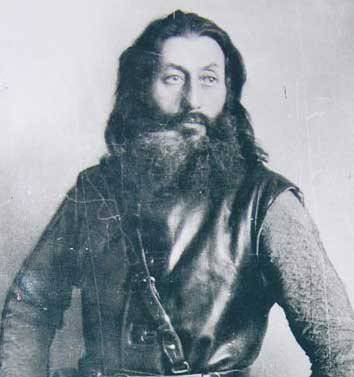 Nestor Aleksandrovich Kalandarishvili (1876-1922) came from an impoverished family of Georgian noblemen who lived in the village of Kviriket in the Ozurgeti district of Kutaisi province. In addition to Nestor, there was another son and three daughters in the family of his father. At the age of eight, Nestor was sent to a village school, from where, on the advice of a teacher, they were sent to study at a gymnasium in the city of Kutaisi, where more prosperous relatives of the family lived. After graduating from high school, Nestor entered the Tiflis Teacher's Seminary. In 1895, he was drafted into the army. Nestor's service was held in the Vladimir Infantry Regiment stationed in Tbilisi. After demobilization, Nestor continued his studies and in 1900, he became close to the circle of socialists - revolutionaries who were active in the teachers' seminary, agitating the future teachers. In 1903, for political activities, Nestor was expelled from the gymnasium. At the same time, he finally chose the path of a professional revolutionary and received the training of a cavalryman in underground military courses organized by the Socialist Revolutionary Party.
Nestor Aleksandrovich Kalandarishvili (1876-1922) came from an impoverished family of Georgian noblemen who lived in the village of Kviriket in the Ozurgeti district of Kutaisi province. In addition to Nestor, there was another son and three daughters in the family of his father. At the age of eight, Nestor was sent to a village school, from where, on the advice of a teacher, they were sent to study at a gymnasium in the city of Kutaisi, where more prosperous relatives of the family lived. After graduating from high school, Nestor entered the Tiflis Teacher's Seminary. In 1895, he was drafted into the army. Nestor's service was held in the Vladimir Infantry Regiment stationed in Tbilisi. After demobilization, Nestor continued his studies and in 1900, he became close to the circle of socialists - revolutionaries who were active in the teachers' seminary, agitating the future teachers. In 1903, for political activities, Nestor was expelled from the gymnasium. At the same time, he finally chose the path of a professional revolutionary and received the training of a cavalryman in underground military courses organized by the Socialist Revolutionary Party. After moving from Tbilisi to Batumi, Kalandarishvili worked as a teacher there, then served as a clerk in the plant management at one of the Rothschild enterprises. In 1904, Nestor switched to the position of the Socialist Party of Federalists, which we wrote about above. In 1905, he participated in the famous Batumi uprising, was an active militant of the local squad. The defeat of the uprising forced him to flee to Kutaisi, where Nestor got a job as an actor in the local theater and, at the same time, met with the Kutaisi anarchists. The latter managed to slander Kalandarishvili and he, having left the ranks of the socialist federalists, plunged into the activities of a group of anarchist communists. In his autobiography, he then recalled: “a memorable life for every old revolutionary began with all its“ charms ”: hiding, shooting, climbing through pipes, jumping over fences, etc.” (Kogevin VE, Legendary partisans of Siberia. Irkutsk , 1971. Page 11.).
Nestor Kalandarishvili created a small partisan detachment of anarchists, who under his leadership took part in the expropriation and attacks on police and gendarmes. Nestor was repeatedly detained by the police, due to which he visited almost all the prisons of Georgia - Batumi, Kutaisi, Sukhumi and Tbilisi. Nevertheless, he always managed to get off the hook, avoiding punishment for lack of evidence. In the 1907 year, after the final suppression of the revolutionary movement in Georgia, Kalandarishvili fled to Siberia. In 1908, he stopped in Irkutsk, where he married Christina Leontyevna Mkeravali. Friend Kalandarishvili S.I. Nazmov helped the runaway anarchist get a job as a photographer. At the same time, the revolutionary participated in the activities of the Irkutsk Theater.
In Irkutsk, Kalandarishvili contacted the local diaspora of Georgian exiled revolutionaries, and got in touch with the anarchists operating in the city. Nestor's attention was attracted by the mines of the Cheremkhovo Basin, where many Georgians and Ossetians expelled from Georgia worked - participants in the revolutionary events of 1905-1907, who fought as part of the “red hundreds”. Kalandarishvili often visited Cheremkhovo, which is also noted by his then associate MV Tsereteli is a former Kutaisi schoolboy who worked as a miner in Cheremkhovo.
The revolutionary activities in Irkutsk also did not go unnoticed by the local authorities. Kalandarishvili was arrested several times, but with the help of an experienced lawyer O.B. Patushinsky was released for lack of evidence of a crime. The last trial of Nestor Kalandarishvili and his comrades Machavariani, Solomon Ordzhonikidze, Gorgeladze, Tseitlin, Tomashevich, Zavyalov and Beloslyudtsev took place in May 1914 of the year, but, as before, ended with an acquittal.
When a revolution occurred in 1917, Georgian revolutionaries who lived in Irkutsk became involved in active work. A Red Guard detachment of sixty Georgian anarchists was created. Nestor Kalandarishvili took command of the detachment, his assistants were: the former worker of the Batumi Rothschild plant and the Red Hundred fighter Mikhail Asatiani, the member of the Guri uprising Iosif Kiguradze, the former shepherd from Megrelia Vano Harchilava, the Kutaisi anarchist Mikhail Tsereteli, the peasant, the “red lotist,” the Red Nurse, the Red Nurse, and the “Red Nurse” Zoidze It was Kalandarishvili’s detachment that formed the backbone of a later partisan army that fought throughout Eastern Siberia against the troops of Semenov, Kappel and Ungern.
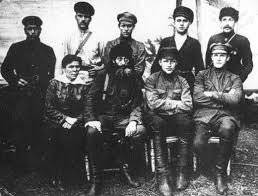 Kalandarishvili's authority in the red partisan movement in Siberia was so high that he received the respectful nickname “Grandfather” and even won a meeting with Vladimir Ilyich Lenin, which occurred while accompanying the Chinese Communist mission to Moscow, trusted Kalandarishvili. Having entered into an alliance with the Bolsheviks, Kalandarishvili taught the appointment of the commander of the cavalry troops of the Far Eastern Republic. In 1921, he joined the RCP (B.), Stating that he now considers himself a Communist Bolshevik, and not an anarchist Communist. A year later, in 1922, Nestor Kalandarishvili, at the age of 46, died in Yakutia - on March 6, his unit was ambushed by anti-Bolshevik Yakut rebels. The entire headquarters, headed by the "Siberian Grandfather" himself, was destroyed.
Kalandarishvili's authority in the red partisan movement in Siberia was so high that he received the respectful nickname “Grandfather” and even won a meeting with Vladimir Ilyich Lenin, which occurred while accompanying the Chinese Communist mission to Moscow, trusted Kalandarishvili. Having entered into an alliance with the Bolsheviks, Kalandarishvili taught the appointment of the commander of the cavalry troops of the Far Eastern Republic. In 1921, he joined the RCP (B.), Stating that he now considers himself a Communist Bolshevik, and not an anarchist Communist. A year later, in 1922, Nestor Kalandarishvili, at the age of 46, died in Yakutia - on March 6, his unit was ambushed by anti-Bolshevik Yakut rebels. The entire headquarters, headed by the "Siberian Grandfather" himself, was destroyed. The fate of other leaders of Georgian anarchism took shape in different ways - someone disappeared without a trace in hard labor, someone died in the civil fire. With regard to the most significant figures: In 1925, at the age of 79, Varlaam Cherkezov, the legendary founder of the anarchist trend in Georgian populism, died. In 1924, 47-year-old Georgy Gogelia died in the Tiflis tuberculosis hospital (Tbilisi). It is significant that his funeral was organized by the Soviet government - a prominent anarchist was buried as an outstanding revolutionary in the absence of his associates, most of whom were repressed by the new revolutionary government.
Despite the spread of anarchism in Georgia, adherents of absolute powerlessness failed not only to put their ideas into practice, but also to accomplish in Georgia something similar to the anarchist experiments of Nestor Makhno in Ukraine or the Spanish anarcho-syndicalists during the Spanish Civil War. Nestor Kalandarishvili, Makhno’s namesake, is sometimes called the “Siberian dad.” But we should not forget that he entered the history as a military, partisan commander, and not as the embodiment of a social experiment. At the same time, the ideological opponents of the anarchists of Georgia - Georgian social democrats and subsequently the Bolsheviks managed to play a role in the history of Russia that is not proportional to their number, nor, actually, to the value of Georgia in national history. It is from Georgia, as everyone knows, a whole galaxy of titled Bolsheviks came out, including such famous people as Yenukidze, Ordzhonikidze, Japaridze, Beria, and, of course, Joseph Stalin-Dzhugashvili himself.
Information